Exceptional experience – this is a must-see. The museum not only is world-class in every way, it stands out for its balanced presentation.
TripAdvisor Review
Experience the eventful and triumphant life of America’s 33rd president. Harry S. Truman’s story is richly and uniquely American. From humble beginnings, he rose to become the most powerful man in the world. For nearly eight years, he guided our nation and the world through perilous times, from the ending of World War II to the beginning of the Cold War. Since the Library’s dedication in July 1957, the Harry S. Truman Library and Museum has welcomed and inspired millions of visitors from across the globe.

Gallery Highlights
Plow to Politics
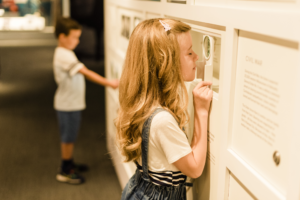
On April 12, 1945, Harry Truman received an urgent call. President Franklin Roosevelt was dead. Truman was a farmer, a war veteran, a failed haberdasher, and a county judge. He was a little-known Senator from Missouri, and Vice President for just 82 days. Now, he was the President of the United States. The world was at war, and the country questioned if he was ready.
To meet the challenges that lay ahead, Truman leaned on his midwestern background, strong values, diverse life experiences, and close personal relationships.
Don’t Miss…
- Introductory Film: An Unlikely President / Elaine and Ken Langone Theatre
- Immersive Theater: Captain Harry: The Great War / Eugene P. Donnelly Gallery
Eye of the Storm
In Honor of Robert Kilker, Jr. and the Headquarters Company of the 103rd Artillery Division
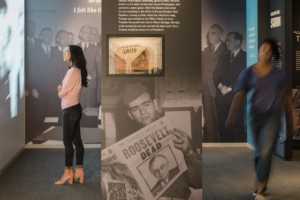 President Roosevelt had shared little with his Vice President. Now Truman faced some of the most momentous decisions ever put before an American President. On the day he was sworn in, President Truman was shaken and uncertain. He had to learn on the job. By August, he was more confident and resolute.
President Roosevelt had shared little with his Vice President. Now Truman faced some of the most momentous decisions ever put before an American President. On the day he was sworn in, President Truman was shaken and uncertain. He had to learn on the job. By August, he was more confident and resolute.
The decisions he made in those chaotic four months ended the Second World War and foreshadowed the immense new challenges of the postwar world.
Don’t Miss…
- Artifact: Einstien to FDR, letter on “The Gadget”
- Video: Lives Lost, Lives Saved
- Infographic: WWII Casualties by Country
Postwar World
William T. Kemper Gallery
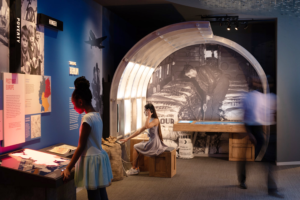
The end of World War II did not slow the pace of the challenges that Harry Truman faced. Much of Europe and Asia lay in ruins, ravaged by starvation and economic collapse. As the only nation to emerge stronger after the war, the United States took the lead. The Soviet Union had suffered catastrophic losses. After the war, it seized control of Eastern Europe to bolster its industries and to create a buffer against future attacks.
Truman aggressively sought to counter Soviet expansionism. This — and preventing a third world war — became his top foreign-policy objective. Tensions between the two nations gave rise to the Cold War.
Don’t Miss…
- Immersive Theater: New Kind of War
- Fractured Globe
- Digital Interactive: The Berlin Airlift

Recognition of Israel
Shirley and Barnett C. Helzberg, Jr.
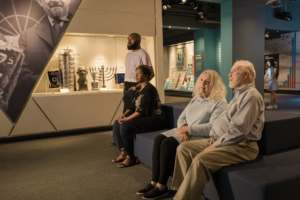 With Cold War tensions growing, and facing a tough reelection campaign, Truman grappled with another issue that would impact American policy for years. After the war, more than 850,000 displaced people, including about 250,000 Jews, could not go home due to ongoing persecution. Allied camps for displaced persons were rife with starvation, disease, and abuse. Displaced Jews sought a home, but many countries, including the United States and Britain, restricted Jewish immigration.
With Cold War tensions growing, and facing a tough reelection campaign, Truman grappled with another issue that would impact American policy for years. After the war, more than 850,000 displaced people, including about 250,000 Jews, could not go home due to ongoing persecution. Allied camps for displaced persons were rife with starvation, disease, and abuse. Displaced Jews sought a home, but many countries, including the United States and Britain, restricted Jewish immigration.
Facing a fierce debate within his inner circle of advisors, Truman had to decide whether to put American support behind the creation of a Jewish state in Palestine. In the end, he recognized the new State of Israel.
Don’t Miss…
- Featured Film: Question of a Jewish Homeland, narrated by Judy Woodruff / Made possible by the generous support of Harvey S. Bodker
What Is Fair?
The Boeing Company
 Harry Truman’s own modest background, reinforced by his appreciation for the shared sacrifices of ordinary fellow Americans during the Second World War, led him to endorse initiatives favoring the common man over business elites. The idea of “fairness” was a guiding principle for Truman. After the war, he sought to hold corporations accountable and address inequality. Yet Congress rejected his ambitious 21-point domestic agenda.
Harry Truman’s own modest background, reinforced by his appreciation for the shared sacrifices of ordinary fellow Americans during the Second World War, led him to endorse initiatives favoring the common man over business elites. The idea of “fairness” was a guiding principle for Truman. After the war, he sought to hold corporations accountable and address inequality. Yet Congress rejected his ambitious 21-point domestic agenda.
In 1948, his growing awareness of racial violence led him to desegregate the military and civilian Federal Government workforce by Executive order. This marked a historic turn in the Democratic Party toward support for civil rights. Truman stunned the nation when he won his 1948 re-election campaign. As President in his own right, he re-branded his agenda the “Fair Deal.”
Don’t Miss…
- Video: Truman and Civil Rights, narrated by Rep. Emanuel Cleaver II
- Digital Interactive: Elections Then and Now
- Whistle Stop Campaign / Kansas City Southern Gallery
Truman’s Second Term
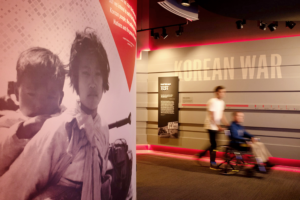 In 1945, Harry Truman had inherited the Presidency upon the death of Franklin Roosevelt. Now, in 1948, Truman was elected in his own right, and his party felt energized following a sweeping electoral victory. Inauguration day showcased Truman’s triumph, but it also turned out to be the high point of his second term.
In 1945, Harry Truman had inherited the Presidency upon the death of Franklin Roosevelt. Now, in 1948, Truman was elected in his own right, and his party felt energized following a sweeping electoral victory. Inauguration day showcased Truman’s triumph, but it also turned out to be the high point of his second term.
The Cold War and domestic opposition darkened the nation’s mood. Revelations of spies within the government and growing anti-Communist paranoia emerged as fierce challenges. Truman confronted real threats from abroad and political pressure from the right. His domestic agenda stalled, and new international threats dominated his remaining years in office.
Don’t Miss…
- Interactive Game: Loyalty Oath
- Featured Film: The Supreme Test, narrated by Clifton Truman Daniel
- Women’s Armed Services Integration Act

The Trumans in Washington
Arvin Gottlieb Gallery
 For almost 18 years, from 1935 to 1953, the Truman family made their home in Washington, D.C., far from their roots in Independence, Missouri. Harry worked hard to distinguish himself as a Senator. Bess adjusted to life in their cramped apartment. Margaret tried to fit in at her new private school.
For almost 18 years, from 1935 to 1953, the Truman family made their home in Washington, D.C., far from their roots in Independence, Missouri. Harry worked hard to distinguish himself as a Senator. Bess adjusted to life in their cramped apartment. Margaret tried to fit in at her new private school.
For the Trumans, family was always a centering force. Sometimes called “The Three Musketeers,” their bond carried them through the years of Senatorial politics, a world war, and the Presidency.
Don’t Miss…
- Artifact: White House Buffalo Mantel
- Digital Interactive: Saving the White House
- Artifact: Bess Truman’s Inaugural Ball Gown
Understanding Democracy
Sherman Family Foundation Gallery
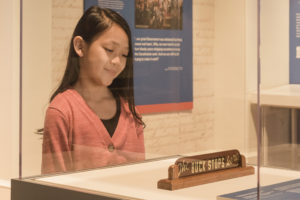
A lifelong student of history and civics, Truman believed it essential for all Americans to know how their government works. His presidential library serves as a classroom for democracy, a place where the public can deepen its knowledge of the system and Truman’s work within it.
In this gallery, visitors can refresh their knowledge of the branches of government, discover what’s on the back of his famous “Buck Stops Here” sign, and step into an exact replica of President Truman’s Oval Office, where some of the most consequential decisions were made by a world leader.
Don’t Miss…
- Gallery: Oval Office Replica, with recorded welcome from President Harry S. Truman
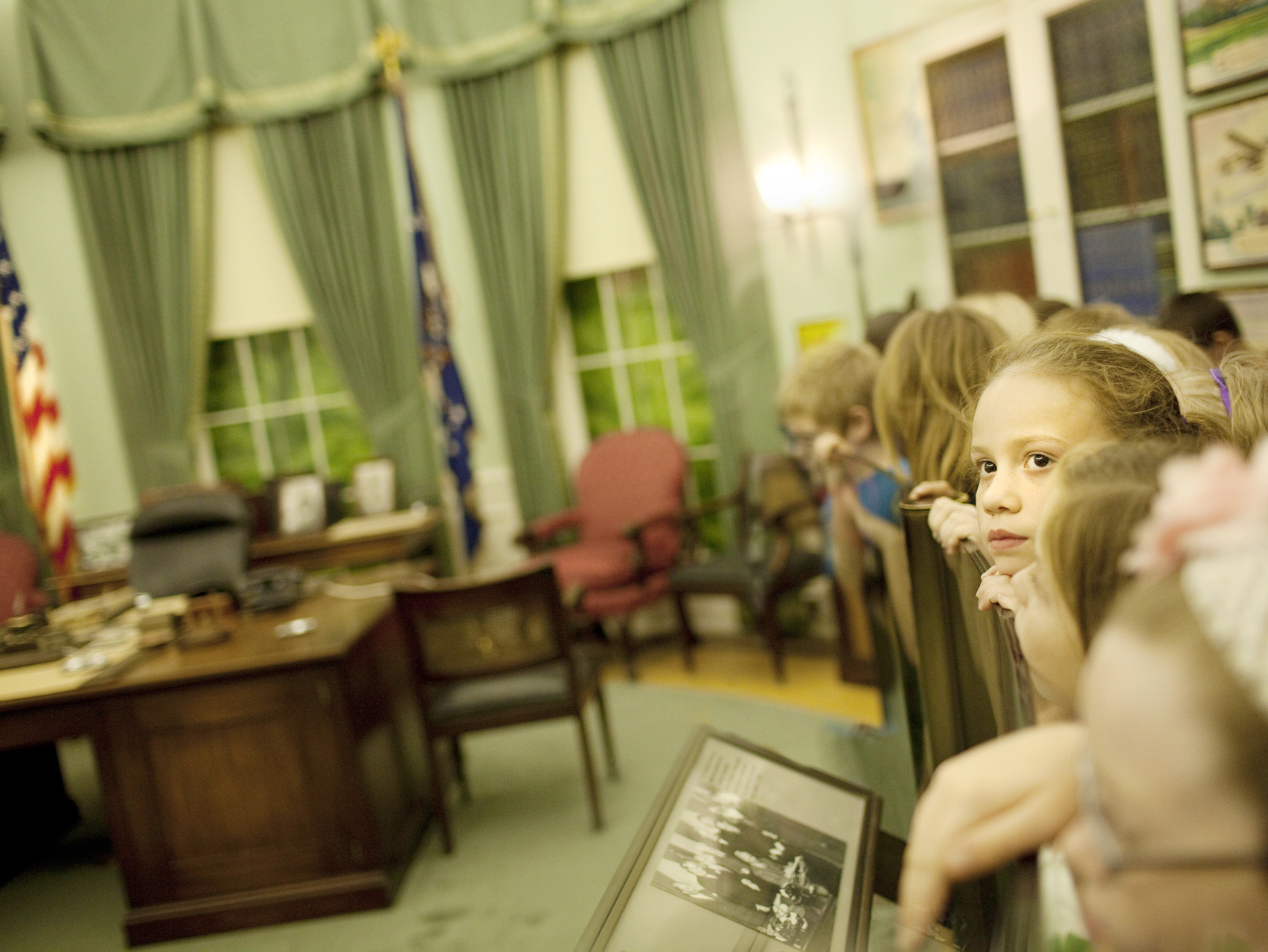
Courtyard
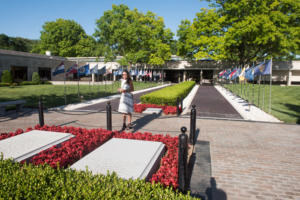
The Truman Courtyard is visited annually by global citizens, leaders, school children and veterans who wish to pay tribute to America’s 33rd President. The burial site for the president and first family, the Courtyard also provides access to President Truman’s Working Office. President Truman worked at the Library almost daily from 1957 until 1966. He met visiting dignitaries, journalists, entertainers and students. He read, wrote, and signed thousands of pieces of correspondence. He also directed many Library activities. Exhibits at the “working office” highlight Truman’s work in his post-Presidential years. Inscribed on the office’s exterior wall is a quotation from a note Truman wrote in 1953: “The Truth Is All I Want for History.”
Don’t Miss…
- Truman’s Working Office / Sosland Foundation Gallery
When you are on vacation, I hope you will visit the educational institution that has been established here in Independence under the name of the Truman Library. As it is set up, it shows exactly what a President has to do.
President Harry S. Truman
Temporary Exhibitions
View current and upcoming temporary exhibitions at the Harry S. Truman Presidential Library & Museum, included with regular Museum admission.


